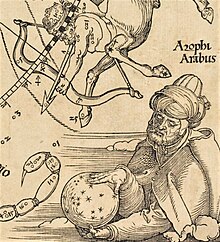
Back Al Soefi Afrikaans عبد الرحمن الصوفي Arabic عبد الرحمن بن عمر الصوفى ARZ Əbdürrəhman əs-Sufi Azerbaijani Abd-ar-Rahman as-Sufí Catalan عەبدولڕەحمان سۆفی CKB Abdurrahmán ibn Umar as-Súfí Czech Abd ar-Rahman as-Sufi German Abd Al-Rahman Al Sufi Spanish Aş-Şūfī Estonian
ʿAbd al-Raḥmān al-Ṣūfī | |
|---|---|
عبدالرحمن الصوفي | |
 Al-Ṣūfī, as depicted in Albrecht Dürer's woodcut Imagines coeli septentrionales cum duodecim imaginibus zodiaci [The Northern Celestial Hemisphere with the Twelve Signs of the Zodiac] (1515) | |
| Born | 7 December 903 |
| Died | 25 May 986 (aged 82) |
| Occupation(s) | Astronomer, mathematician |
| Era | Islamic Golden Age |
| Notable work | Kitāb ṣuwar al-kawākib ("The Book of Fixed Stars") |
ʿAbd al-Raḥmān al-Ṣūfī (Persian: عبدالرحمن الصوفی; 7 December 903 – 25 May 986) was a Persian astronomer.[1][2] His work Kitāb ṣuwar al-kawākib ("The Book of Fixed Stars"), written in 964, included both textual descriptions and illustrations. The Persian polymath Al-Biruni wrote that al-Ṣūfī's work on the ecliptic was carried out in Shiraz. Al-Ṣūfī lived at the Buyid court in Isfahan.
- ^ Al-Qifti. Ikhbār al-ʿulamāʾ bi-akhbār al-ḥukamāʾ ("History of Learned Men"). In: ʿAbd al-Raḥmān al-Ṣūfī and his Book of the Fixed Stars: A Journey of Re-discovery by Ihsan Hafez, Richard F. Stephenson, Wayne Orchiston (2011). In: Orchiston, Wayne, Highlighting the history of astronomy in the Asia-Pacific region: proceedings of the ICOA-6 conference. Astrophysics and Space Science Proceedings. New York: Springer. ISBN 978-1-4419-8161-5. "… is the honored, the perfect, the most intelligent and the friend of the King Adud al-Dawla Fanakhasru Shahenshah ibn Buwayh. He is the author of the most honored books in the science of astronomy. He was originally from Nisa and is of a Persian descent."
- ^ van Gent, Robert Harry. "Biography of al-Sūfī". University of Utrecht. Retrieved 11 January 2014.